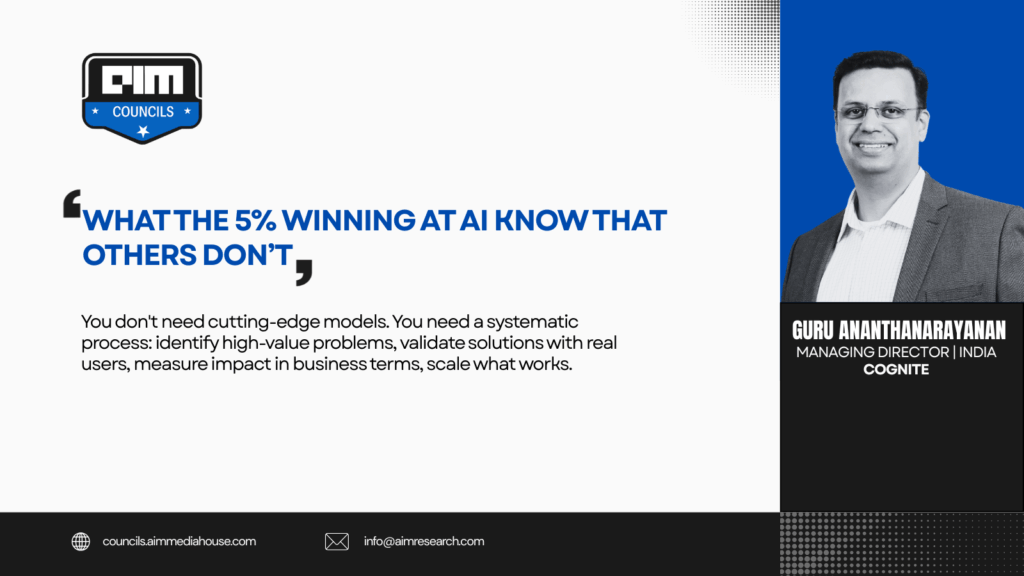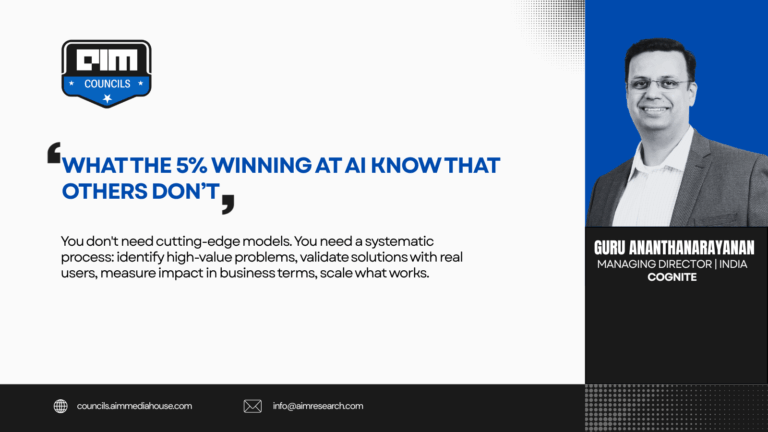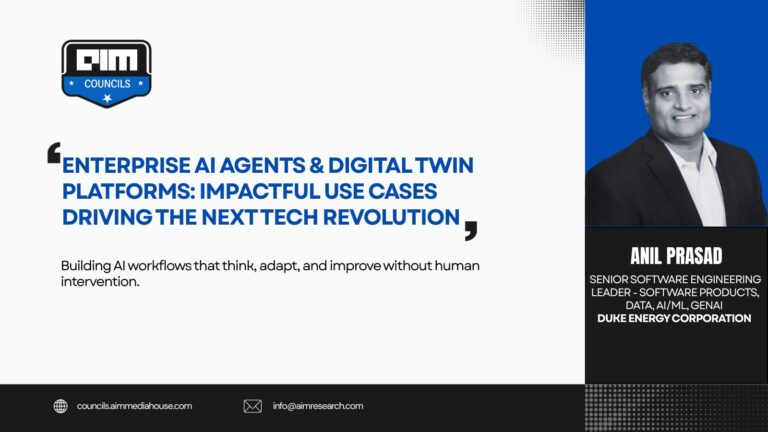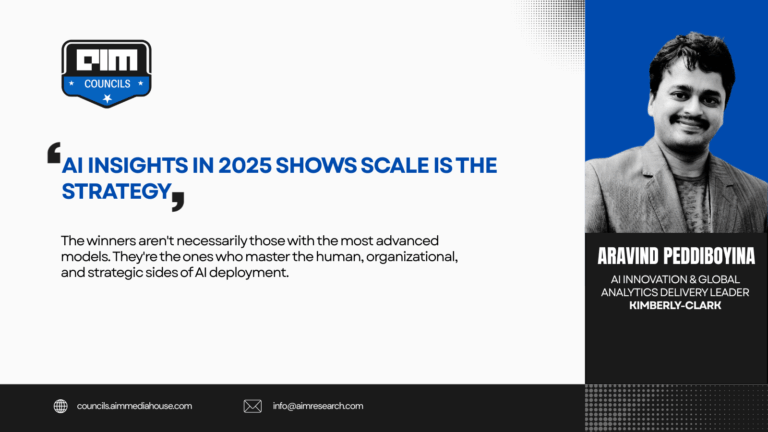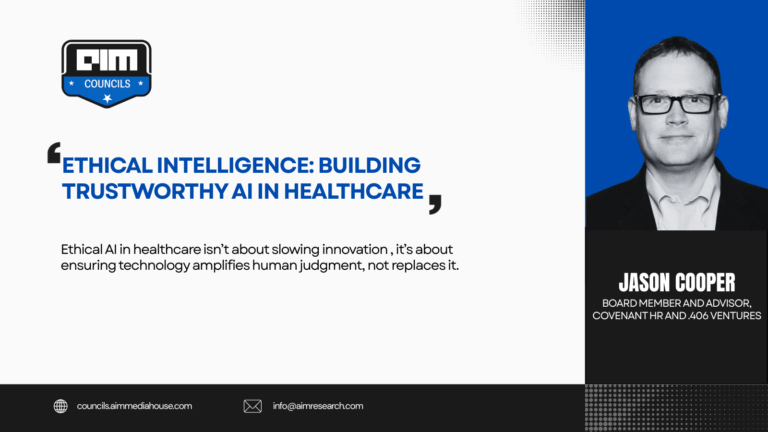Everyone fixates on the 95% that tank. Conferences dedicate panels to it. Consultants build practices around it. Executives cite it to justify inaction.
But there’s a bolder story: the 5% that succeed. They’re not lucky. They’re not using expensive tech. They’re just doing it differently.
While the majority writes post-mortems, this rare breed makes AI look like it’s supposed to: smart and seriously useful.
Most companies treat AI like R&D. The winners treat it like infrastructure.
That one shift changes everything: who builds it, how you measure it, where it lives. When AI is “innovation,” data scientists work in a lab. When it’s infrastructure, it sits with the people running the business.
The Six Rules
The successful 5% follow six principles.
1. They plan before they build
These teams don’t wake up and decide to “sprinkle some AI” on their operations. They start with a real plan.
They ask: What problem are we solving? What does success look like? Who’s going to use this thing?
No vague “let’s be data-driven” nonsense. They have a map before the journey starts. They spend weeks mapping bottlenecks before touching any technology. It’s the only way to solve real problems instead of theoretical ones.
2. Their data doesn’t smell funny
Bad data is like cheap coolant, looks okay at first, then everything seizes up.
The successful 5% are obsessive about data quality. They clean it, tag it, organize it. They build knowledge graphs that map relationships between assets and outcomes. Think Google Maps for your data, connecting machines, materials, people, and processes in one smart network.
When data knows how it relates to other data, magic happens. It doesn’t hallucinate. It stays grounded in reality, real-time.
Not data lakes that pool information without context. This structural advantage makes errors rare and trust high.
3. They pick battles that matter
These teams don’t try to build “AI for everything.” They pick use cases that scream value, the ones that make a manager go, “Wait, you can automate that?!”
Predictive maintenance. Energy optimization. Quality inspection. Supply chain execution. Each has a clear link to money saved, downtime reduced, or throughput increased. In pharma, it could save lives saved. Not everything needs a dollar sign attached.
They don’t fall for shiny tech. They chase meaningful ROI for every use case and measure it.
One wrong recommendation and your AI project becomes the cautionary tale in budget meetings. The 5% never let it get that far.
4. They measure everything
Set up weekly KPI tracking from day one. If you can’t show ROI in business terms within 90 days, you’ve lost support for the next phase.
These winners measure the heck out of success:
- Did downtime drop 20%?
- Did yield go up 5%?
- Did operators stop swearing at dashboards?
- Did the shift supervisor leave by 5pm instead of working overtime?
Yes, that last one matters.
They know what metrics matter before the project starts. They establish baseline metrics months before go-live. They define success in financial and operational terms, not just technical ones.
So when it’s done, they have receipts. And they measure weekly to make sure what they planned for is being achieved.
5. They think in business releases, not science projects
Ever seen an AI project try to solve 20 problems at once and end up solving zero? The 5% know better.
They chunk it down. Business Release 1 delivers something useful. Business Release 2 makes it better.
It’s like a Netflix series, every release leaves you wanting more, not wondering what just happened.
This prevents the scope creep that kills multi-year projects. Early releases expose integration issues and user resistance while stakes are low. By the time you scale, you’ve fixed the process, not just the code.
6. They blend brains, tech meets business
The best AI teams aren’t full of PhDs in hoodies. They’ve got operators, process engineers, IT folks, and business leads all at the same table.
When you combine someone who understands machine vibration with someone who understands machine learning, sparks fly, the productive kind.
Technical feasibility without operational viability is just expensive research.
Most companies hire brilliant technologists, isolate them from reality, then wonder why no one uses the system. The 5% embed technical talent in operational workflows from day one.
What Maturity Actually Looks Like
AI maturity isn’t about sophistication. It’s about repeatability.
You don’t need cutting-edge models. You need a systematic process: identify high-value problems, validate solutions with real users, measure impact in business terms, scale what works. This process orientation transforms one-off wins into sustained advantage.
The companies winning aren’t doing anything you can’t do. They’re not using secret algorithms or proprietary data. They’re just more disciplined, more focused, and more respectful of the operational realities that determine whether technology creates value or just creates noise.
The Choice
Everyone talks about the 95% failure rate. Meanwhile, a quiet minority captures billions.
That’s where the future is being built, quietly, smartly, sustainably. They’re proving that AI works when done right.
While others chase hype, these folks chase value. They show that the glass isn’t 95% empty, it’s 5% full of solid gold.
The difference isn’t technology or budget. It’s approach. Treat AI like infrastructure, not innovation. Start with business problems, not technical capabilities. Ship small, measure constantly, and put domain experts in the room from day one.
Don’t fear the stats. Be the exception.
One approach keeps you in the 95%. The other makes you the standard.
Which one do you want?

